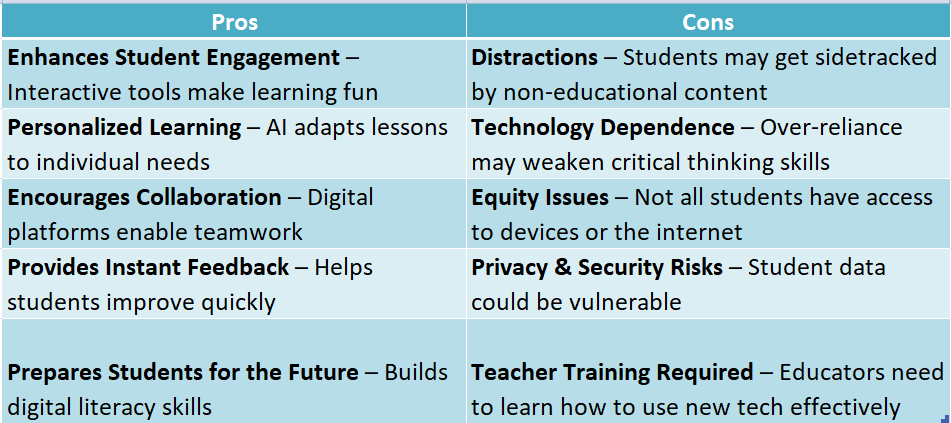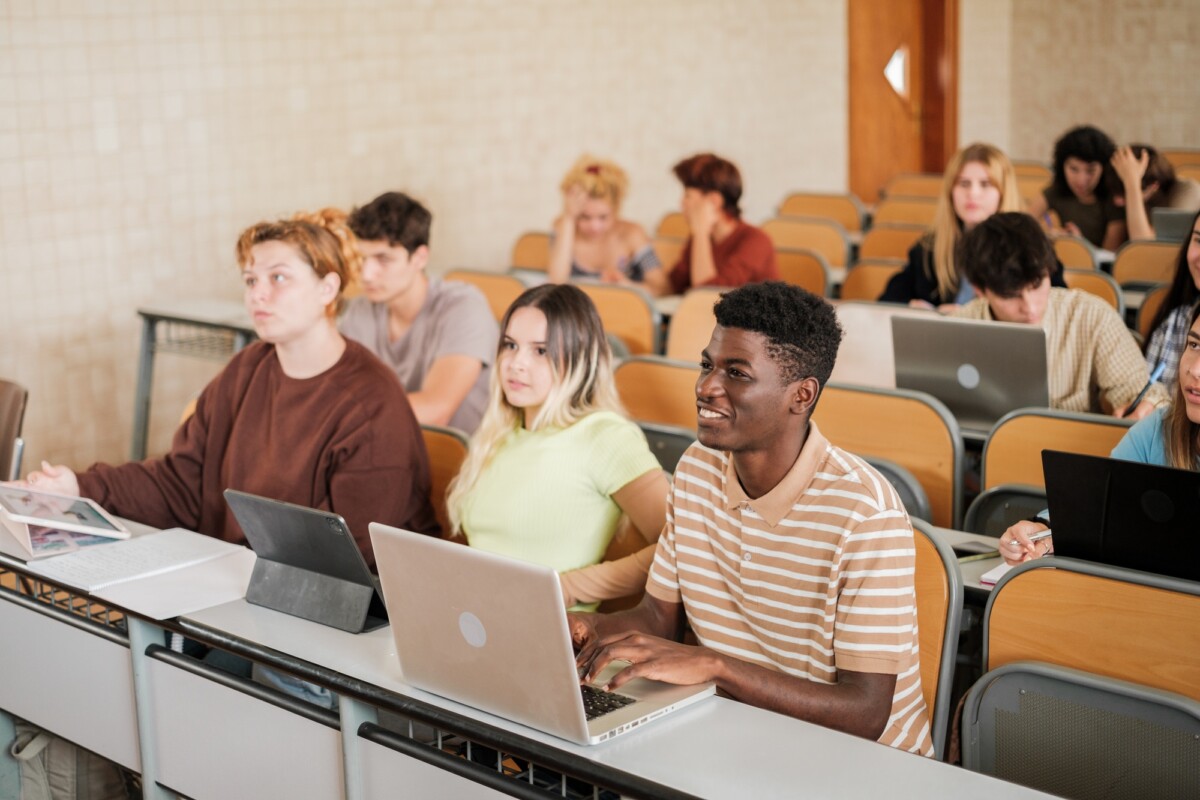
In today’s educational landscape, Technology in the Classroom plays a crucial role in modern classrooms, enhancing learning experiences and fostering student engagement. By integrating various technological tools, educators can create dynamic environments that cater to diverse learning styles, making education more accessible and enjoyable for all.
Interactive Learning Tools
- Smartboards: Facilitate interactive lessons that captivate students’ attention.
- Educational Apps: Make complex subjects more approachable and fun.
AI in Education
How can students use AI in school? AI supports personalized learning, allowing students to grasp concepts at their own pace through chatbots and AI-driven tutoring systems, empowering them to take charge of their learning journey.
Virtual Reality Experiences
Top educational VR products can transport students to historical sites or outer space, offering immersive experiences that traditional textbooks cannot. This enhances understanding and sparks curiosity, making learning an exciting adventure.
Unlock your potential with online degrees—Learn more!
The Benefits of Interactive Learning Tools in Modern Education
In today’s educational landscape, technology in modern classrooms plays a vital role. Interactive learning tools engage students and enhance their understanding of complex concepts, creating a dynamic environment that caters to diverse learning styles.
Enhanced Engagement
Interactive tools like educational apps and games captivate students’ attention, encouraging active participation and making learning enjoyable and effective.
Personalized Learning Experiences
Technology allows students to learn at their own pace. AI-driven platforms provide tailored educational experiences, ensuring each student receives the necessary support.
Immersive Learning with VR
Top educational VR products transport students to different worlds, making lessons unforgettable. For example, exploring ancient civilizations or the human body through virtual reality fosters deeper understanding and knowledge retention.
By leveraging these interactive tools, educators can transform traditional teaching methods into innovative experiences, highlighting that technology is not just a tool but a vital partner in education.

Are Traditional Teaching Methods Still Relevant in a Tech-Driven Classroom?
In today’s educational landscape, the role of technology in modern classrooms cannot be overstated. As educators embrace digital tools, they must also consider the relevance of traditional teaching methods. The integration of technology in the classroom has transformed how students learn, making it essential to evaluate the balance between old and new approaches.
The Value of Traditional Methods
While technology enhances learning experiences, traditional teaching methods still hold value. They foster critical thinking and interpersonal skills, which are crucial in a tech-driven world. Educators can blend these methods with modern tools to create a comprehensive learning environment.
Embracing Technology
- Interactive Learning: Technology in the classroom encourages engagement through interactive platforms.
- AI Integration: How can students use AI in school? AI tools can personalize learning, providing tailored resources to meet individual needs.
- Virtual Reality: Exploring the top educational VR products can immerse students in subjects like history or science, making lessons more memorable.
Exploring the Impact of Virtual Reality on Student Learning Experiences
In today’s educational landscape, technology plays a crucial role in transforming traditional classrooms into dynamic learning environments. One of the most exciting advancements is Virtual Reality (VR), which provides immersive experiences that enhance student understanding and retention.
Immersive Learning Environments
VR technology allows students to explore complex concepts tangibly. For example, rather than just reading about historical events, they can virtually walk through ancient civilizations, making learning more engaging.
Benefits of VR in Education
- Enhanced Engagement: Students actively participate when learning through VR.
- Real-World Applications: VR simulates real-world scenarios, aiding practical application of theoretical knowledge.
- Collaboration Opportunities: VR platforms enable collaborative projects, promoting teamwork and communication skills.
As educators leverage technology in the classroom, they also consider how AI can assist students. For instance, how can students use AI in school to personalize their learning experiences? Integrating these technologies paves the way for a more interactive and effective educational journey.
How Can Educators Effectively Integrate Technology in the Classroom?
In today’s educational landscape, the role of technology in modern classrooms is more significant than ever. It not only enhances learning experiences but also prepares students for a tech-driven world. Educators must embrace innovative tools to create engaging and effective learning environments.
Embrace Collaborative Tools
- Utilize platforms like Google Classroom for assignments and feedback.
- Encourage group projects using tools like Microsoft Teams or Zoom for remote collaboration.
Incorporate AI in Learning
- How Can Students Use AI in School?: Leverage AI tools for personalized learning experiences, helping students grasp complex concepts at their own pace. This can include AI-driven tutoring systems or adaptive learning software.
Explore Virtual Reality
- Consider investing in the Top Educational VR Product for immersive learning experiences. VR can transport students to historical sites or simulate scientific experiments, making lessons more interactive and memorable.
The Role of Collaborative Tools in Fostering Teamwork Among Students
In today’s educational landscape, technology in the classroom plays a pivotal role in enhancing learning experiences. Collaborative tools are at the forefront of this transformation, enabling students to work together seamlessly, regardless of their physical location. By fostering teamwork, these tools not only improve academic performance but also prepare students for future workplace dynamics.
Enhancing Communication
- Real-time Collaboration: Tools like Google Docs allow multiple students to edit documents simultaneously, promoting immediate feedback and discussion.
- Video Conferencing: Platforms such as Zoom facilitate group meetings, making it easier for students to connect and collaborate on projects from anywhere.
Encouraging Creativity
- Interactive Platforms: Using top educational VR products, students can engage in immersive experiences that require teamwork, enhancing their problem-solving skills.
- AI Integration: How can students use AI in school? AI tools can assist in brainstorming ideas, providing suggestions, and even helping with research, making group projects more efficient and innovative.
What Challenges Do Teachers Face When Implementing Technology in the Classroom?
In today’s educational landscape, the role of technology in modern classrooms is pivotal. It enhances learning experiences, fosters engagement, and prepares students for a tech-driven world. However, integrating technology effectively presents several challenges for teachers, who must navigate these hurdles to maximize its benefits.
Limited Training and Support
Many educators feel unprepared to incorporate technology in the classroom. Without adequate training, they struggle to utilize tools effectively, such as the top educational VR products that can transform lessons into immersive experiences.
Resistance to Change
Some teachers may resist adopting new technologies due to comfort with traditional methods. This reluctance can hinder the integration of innovative solutions, like how students can use AI in school to enhance their learning and creativity.
Unlock your potential with online degrees—Learn more!
The Future of Education: Trends in Classroom Technology You Should Know
In today’s fast-paced world, the role of technology in modern classrooms is more crucial than ever. It not only enhances learning experiences but also prepares students for a tech-driven future. As we look ahead, understanding the trends in classroom technology can help educators and students alike make the most of these advancements.
Integration of AI in Learning
How can students use AI in school? AI tools can personalize learning experiences, providing tailored resources that cater to individual needs. From intelligent tutoring systems to AI-driven assessments, these technologies empower students to learn at their own pace, making education more accessible and engaging.
Rise of Virtual Reality (VR)
The top educational VR products are transforming how students interact with content. By immersing learners in virtual environments, VR enhances understanding of complex subjects, such as history and science. This hands-on approach not only captivates students but also fosters deeper learning and retention of information.
How ‘CollegeAndTuition.com’ Supports Educators in Adopting Classroom Technology
In today’s educational landscape, technology is crucial for enhancing learning experiences. By integrating digital tools, educators can create engaging and interactive environments. ‘CollegeAndTuition.com‘ plays a vital role in supporting teachers who want to adopt classroom technology effectively.
Comprehensive Resources
‘CollegeAndTuition.com’ provides a variety of resources, including guides and tutorials, to help educators implement technology confidently. This support is essential for using tools like AI and VR, which boost student engagement.
Professional Development Opportunities
Through workshops and training sessions, ‘CollegeAndTuition.com’ empowers educators to explore how students can use AI in school. These opportunities keep teachers informed about the latest trends, ensuring they deliver the best learning experiences.
Access to Top Educational VR Products
Additionally, ‘CollegeAndTuition.com’ curates top educational VR products, simplifying the process for educators to find suitable tools. This support allows teachers to focus on what truly matters: fostering a love for learning among their students.
Measuring Success: Evaluating the Effectiveness of Technology in the Classroom
In today’s educational landscape, the role of technology in modern classrooms is more significant than ever. It not only enhances learning experiences but also equips students with essential skills for the future. Evaluating the effectiveness of these technologies is crucial to ensure they meet educational goals and foster student engagement.
Key Metrics for Evaluation
- Student Engagement: Are students more involved and interested in lessons?
- Academic Performance: Is there an improvement in grades and test scores?
- Skill Development: How can students use AI in school to enhance critical thinking and problem-solving skills?
Tools for Assessment
To effectively measure success, educators can utilize various tools, such as:
- Surveys and Feedback: Collecting student and teacher feedback on technology use.
- Performance Analytics: Tracking progress through educational software.
- Comparative Studies: Analyzing outcomes between tech-integrated and traditional classrooms.
By focusing on these metrics, schools can identify the top educational VR products and other technologies that truly enhance learning.
Unlock your potential with online degrees—Learn more!
FAQs
-
Why is technology important in the classroom?
Technology enhances learning by providing interactive, engaging, and personalized educational experiences. -
At what age should children start using technology for learning?
While supervised exposure can begin in early childhood, structured learning with technology is most effective in preschool and beyond. -
What are the benefits of using technology in education?
It improves engagement, supports different learning styles, provides instant access to information, and fosters collaboration. -
What types of technology are commonly used in classrooms?
Tablets, interactive whiteboards, educational apps, virtual reality, AI-powered tools, and online learning platforms.





